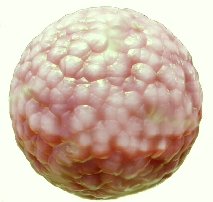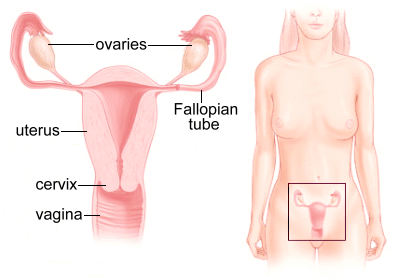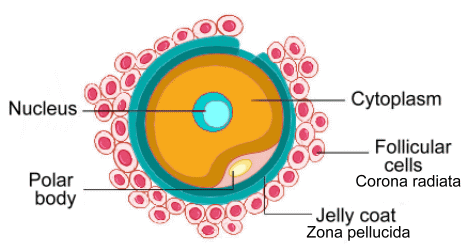  The egg cell, or ovum, is the female reproductive cell, or gamete. The human egg is one of the largest cells in the human body, although it is still very small, measuring just one tenth of a millimetre in diameter.
The egg cell, or ovum, is the female reproductive cell, or gamete. The human egg is one of the largest cells in the human body, although it is still very small, measuring just one tenth of a millimetre in diameter.Eggs are produced in the ovaries, which are normally situated towards the back of a woman's abdomen, below the kidneys. The eggs develop from tiny cells inside the ovaries, going through various stages of development, known as oogenesis, until they are released once a month during ovulation. Usually each ovary takes turns releasing an egg every month.  A woman is born with approximately 500,000 potential eggs in each ovary, each contained in its own small sac of fluid called a follicle. The female reproductive system consists of two ovaries, two fallopian tubes, the uterus, the cervix, and the vagina.
A woman is born with approximately 500,000 potential eggs in each ovary, each contained in its own small sac of fluid called a follicle. The female reproductive system consists of two ovaries, two fallopian tubes, the uterus, the cervix, and the vagina. The ovaries store and release eggs. When an egg is released (ovulation) it moves through a fallopian tube and into the uterus. Pregnancy can occur if an egg is fertilized by a sperm cell; it then attaches to the lining of the uterus, where the fertilized egg grows. If a fertilized egg doesn't attach, the uterus sheds its lining as a menstrual period. From birth onwards a woman will not produce any more eggs; in fact the number of eggs will steadily decrease over her lifetime as they are absorbed back into the body. Given an average span of 40 years between puberty and menopause, with one egg being released per month, only 400-500 eggs in total will actually be released. By the time a woman reaches menopause, few follicles remain. The Egg Cell  Nucleus:
Nucleus:The nucleus is the heart of the egg cell, containing most of the genetic material in the form of DNA, made of long lengths of chromosomes containing the genetic material in genes. An egg, like a sperm, contains half the number of chromosomes of a normal cell, i.e. 23 each. So once an egg and sperm combine, the resulting embryo will have the normal 46 chromosomes. Cytoplasm: The cytoplasm is a gel-like substance that holds all the cell's other internal structures, called organelles. It is in the cytoplasm that all the cell's activities take place to keep it alive and functioning properly. Amongst the more important organelles are structures called mitochondria, which supply most of the energy for the cell. These features are common to all cells. Zona Pellucida: The zona pellucida is an outer membrane or cell wall. It has the special function of allowing just one sperm to attach and its gentic material to enter the egg through its hard outer layers. Following ovulation, the egg is capable of fertilization for just 12-24 hours. The zona pellucida contains sperm receptors which are specific for human sperm. Once this membrane has been penetrated by one sperm, it becomes impermeable to penetration by others. Corona Radiata: The corona radiata surrounds an egg and consists of two or three layers of cells from the follicle. They are attached to the zona pellucida – the outer protective layer of the egg; their main purpose is to supply vital proteins to the cell. Following penetration of the egg by a sperm, the egg is ready for cell division. The single-cell embryo is called a zygote. Over the course of the next seven days, the human embryo undergoes multiple cell divisions in a process called mitosis.  At the end of this transition period, about five to six days after fertilization, the embryo becomes a mass of about 200-300 very organized cells called a blastocyst. An inner group of these cells will become the actual embryo; an outer group will become the cells that nourish and protect it. |